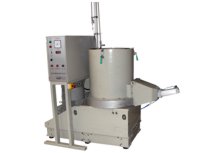Aglomerator NA 15A, NA 15B
TECHNICAL DATA1
| Charge weight | 10 + 15 kg |
| Cycle time | 6 + 8 min |
| Hourly output | 70 + 100 kg.hour-1 |
| Machine dimensions (l x w x h) | 1300 x 720 x 1550 mm |
| Machine weight | 850 kg |
| Maximum water consumption | 10 l.hod-1 |
| Pressure air | 0,6 MPa |
| Maximum air consumption at 0,6 MPa | 6 l.hour-1 |
| Electrical voltage | 3 x 400/230 V, 50 Hz |
| Total installed capacity | 22 kVA |
| Average power input | 14 kVA |
USE
The machine is intended for the processing of non-contaminated wastes of polyolefin (especially LDPE and HDPE) foils generated in the production or further processing of these foils. The process results in sinter with a grain size of 2 – 5 mm that may be without further treatment used as feed material in the extrusion process. In the case of less demanding applications, the sinter can be used separately; usually, it is mixed in a corresponding ratio to a new granulate.
FUNCTION
The equipment sinters the waste in cyclic feeds. The pre-weighed foil waste is gradually fed to the working space of the machine where it is cut and crushed by the set of stationary and rotating knives and, at the same time, melted down on its surface due to heat generated in the cutting. The process results in a gradual increase in the temperature in the working space of the machine that is continuously monitored. After a period of time required by technology and with an achieved required temperature of the charge, a measured quantity of water is injected into the working space of the machine under the continuous operation of the knife rotor. At the same time, the exhaust fan ensuring the outlet of generated steam is turned on. Due to rapid cooling, the particles conglomerate into the sinter with a defined bulk density that is released from the sinter vessel through the pneumatically operated side door and the whole cycle can be repeated.
ADVANTAGES
The processing of the foil waste at the producer’s site facilitates a very effective utilisation of the feed material waste generated in the production start-up time, edge trimming, and cutting, as well as of cut-outs from the automatic welding machines, non-conforming products, etc. The waste sintering process does not lead to the thermal degradation of the material; its limiting viscosity number does not change actually. The lower risks than the use of usual granulate. Due to a multiple reduction of the material volume, the waste sintering process also reduces the costs of the storage facilities and costs of the transport of wastes to another processor. Low power demand through the waste processing. Quick preparation of the waste sintering operating.
1 ) Changes in technical parameters reserved.
SEKON plast s.r.o., tř. T. Bati 299, 763 02 Zlín, Czech Republic, Home Page, sekon@sekon.cz




